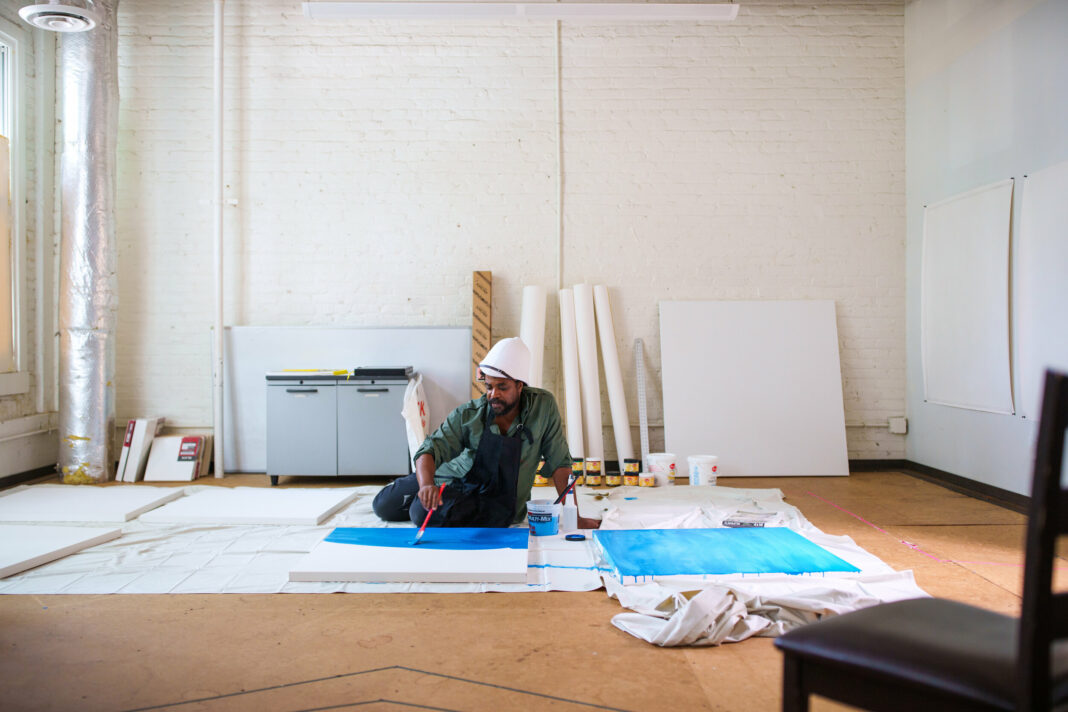Artist Residencies
Let’s dive into the world of artist residencies, answering your questions with detailed explanations and insights:
What is an artist residency?
An artist residency program gives artists time, space, and resources to focus on their creative practices. These programs often involve living and working in a dedicated environment, sometimes alongside other artists or within a supportive community. Various organizations can host residencies, from museums and universities to national parks and community centers.
Why are artist residencies meaningful?
Residencies offer numerous benefits:
- Dedicated time and space: Artists get a break from daily routines and distractions, allowing them to immerse themselves in their work.
- Inspiration and new perspectives: New environments, communities, and collaborations can spark creativity and lead to innovative approaches.
- Professional development: Residencies often include workshops, talks, and critiques, fostering artistic growth and career advancement.
- Support and resources: Studios, materials, and sometimes even stipends can be provided, easing financial burdens and enabling artists to experiment.
- Community and networking: Connecting with other artists, curators, and art professionals creates valuable relationships and new opportunities.
Why do artists participate in residencies?
Artists participate in residencies for various reasons:
- To delve deeper into existing projects: They get uninterrupted time to develop ongoing artwork, research, or writing.
- To experiment and explore new ideas: The change of scenery and lack of routine can inspire innovation and push artistic boundaries.
- To gain exposure and connect with the art world: Residencies often involve exhibitions, presentations, or community engagement, broadening the artist’s audience and network.
- To recharge and refresh their creative practice: A focused break allows artists to overcome creative blocks and rekindle their artistic passion.
- To gain new skills and knowledge: Workshops, talks, and collaborations can enhance their artistic toolbox and expand their understanding of the art world.
Do artists get paid for residencies?
This varies greatly. Some residencies offer stipends covering living expenses and materials. Others are unpaid but provide free accommodation and studio space. There are also residencies with fees, requiring artists to cover their costs.
Are artist residencies worth it?
Deciding whether a residency is “worth it” is subjective and depends on individual goals and circumstances. Factors to consider include:
- Personal needs and career stage: Does the residency align with your artistic and professional aspirations?
- Program focus and resources: Does it offer the space, materials, and support you need?
- Financial considerations: Can you afford the costs, or will the benefits outweigh them?
- Location and community: Will the environment stimulate creativity and provide valuable connections?
Ultimately, participating in a residency is a personal decision. Carefully research different programs and weigh the benefits and drawbacks before deciding if it’s the right choice for you.
How long is an artist in residence?
The duration of residencies varies widely, ranging from a few weeks to several months or even a year. Some offer flexible options, allowing artists to tailor the duration to their needs.
What is the difference between an artist retreat and a residency? Both provide dedicated time and space for artistic exploration, but there are some key differences. Residencies often have a specific theme or program, while retreats focus on individual artistic development. Residencies can involve scheduled activities like workshops or critiques, while retreats offer more open-ended schedules. Residencies may incorporate interaction with other artists or the local community, while retreats can be more solitary experiences.
What do residencies offer artists? Besides time and space, residencies can offer studio facilities and materials, professional development opportunities like workshops and mentorship from established artists and curators, financial support like stipends and travel grants, community engagement like exhibitions and projects involving the local community, and networking opportunities with other artists, curators, and art professionals.
What types of artist residencies are there? Residencies cater to diverse artistic disciplines and interests, including visual arts like painting, sculpture, photography, and printmaking, literary arts like writing, poetry, and translation, performing arts like music, dance, theater, and performance art, multimedia arts like film, video, digital art, and interactive installations, and interdisciplinary arts that combine multiple disciplines or explore specific themes like social justice or environmental issues.
Do artist residencies make money? Most artist residencies are not designed for artists to make money directly, but they can indirectly contribute to income generation in several ways. For example, the program’s publicity and potential exhibitions or presentations can bring your work to a broader audience, leading to future sales or commissions. The experience, skills gained, and connections made during the residency can also elevate your standing in the art world, opening doors to paid opportunities like grants or residencies with financial support. Additionally, the dedicated time and focused environment may lead to new artworks or projects with potential for sales or exhibitions.
What are the characteristics of a good artist residency? Finding the right residency depends on your artistic goals and needs, but some general characteristics indicate a high-quality program. Look for a residency that aligns with your artistic practice, has a supportive community and environment with opportunities for interaction and collaboration, offers dedicated workspace and materials that match your creative needs, provides professional development opportunities like access to workshops, lectures, or mentorship, has a funding structure that aligns with your budget, and is located in a place that offers inspiration and potential connections. Ultimately, researching carefully and choosing a residency based on your needs and aspirations is vital to a fulfilling and valuable experience.
What is the difference between an artist retreat and a residency?
Both provide dedicated time and space for artistic exploration, but there are key differences:
Focus: Residencies often have a specific theme or program, while retreats focus on individual artistic development.
Structure: Residencies often involve scheduled activities like workshops or critiques, while retreats offer more open-ended schedules.
Community: Residencies may incorporate interaction with other artists or the local community, while retreats can be more solitary experiences.
What do residencies offer artists?
Beyond time and space, residencies can offer:
Studio facilities and materials: Dedicated workspaces equipped with tools and resources needed for specific artistic disciplines.
Professional development opportunities: Workshops, lectures, and mentorship from established artists and curators.
Financial support: Stipends, travel grants, or access to funding opportunities.
Community engagement: Exhibitions, presentations, or projects involving the local community.
Networking opportunities: Connecting with other artists, curators, and art professionals.
What types of artist residencies are there?
Residencies cater to diverse artistic disciplines and interests, including:
Visual arts: Painting, sculpture, photography, printmaking, etc.
Literary arts: Writing, poetry, translation, etc.
Performing arts: Music, dance, theater, performance art, etc.
Multimedia arts: Film, video, digital art, interactive installations, etc.
Interdisciplinary: Combining multiple artistic disciplines or exploring specific themes, such as social justice or environmental issues.
What do artist residencies offer artists?
Residencies offer various benefits besides time and space:
Studio facilities and materials: Dedicated workspaces with tools and resources suited to specific artistic disciplines.
Professional development opportunities: Workshops, lectures, and mentorship from established artists and curators to accelerate artistic growth.
Financial support: Stipends, travel grants, or access to funding opportunities to ease financial burdens and enable experimentation.
Community engagement: Exhibitions, presentations, or projects involving the local community can provide exposure and build connections.
Networking opportunities: Connecting with other artists, curators, and art professionals expands your network and opens up new possibilities.
What types of artist residencies are there?
The diversity of residencies is vast, catering to varied artistic disciplines and interests. Here are some examples:
Visual arts: Painting, sculpture, photography, printmaking, etc.
Literary arts: Writing, poetry, translation, etc.
Performing arts: Music, dance, theater, performance art, etc.
Multimedia arts: Film, video, digital art, interactive installations, etc.
Interdisciplinary: Combining multiple artistic disciplines or exploring specific themes, such as social justice or environmental issues.
Do artist residencies make money?
Most artist residencies are designed for something other than artists to make money directly. However, they can indirectly contribute to income generation in several ways:
Increased exposure: The program’s publicity and potential exhibitions or presentations can bring your work to a broader audience, leading to future sales or commissions.
Enhanced career prospects: The experience, skills gained, and connections made during the residency can elevate your standing in the art world, opening doors to paid opportunities.
Grant funding: The residency can serve as a springboard for applying for grants or residencies with financial support.
Creative output: The dedicated time and focused environment may lead to new artworks or projects with potential for sales or exhibitions.
What are the Characteristics of a Good Artist Residency?
Finding the right residency depends on your artistic goals and needs. However, some general characteristics indicate a high-quality program:
Alignment with your artistic practice: The residency’s focus and resources should match your artistic discipline and interests.
Supportive community and environment: Look for a welcoming atmosphere with opportunities for interaction and collaboration.
Dedicated workspace and materials: The studio facilities and provided materials should meet your specific creative needs.
Professional development opportunities: Access to workshops, lectures, or mentorship adds value and fosters artistic growth.
Financial considerations: Understand the funding structure (stipends, fees, etc.) and ensure it aligns with your budget.
Location and context: Consider if the residency’s location and surrounding community offer inspiration and potential connections.
Ultimately, researching carefully and choosing a residency based on your needs and aspirations is vital to a fulfilling and valuable experience.













